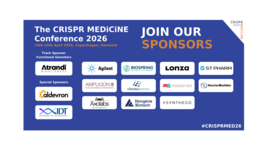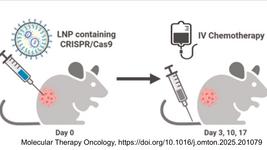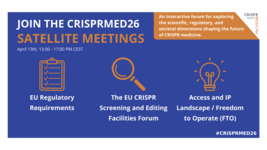CMN Weekly (6 December 2024) - Your Weekly CRISPR Medicine News
By: Gorm Palmgren - Dec. 6, 2024
Top picks
- In the pursuit of a precise way to control CRISPR-mediated gene editing, scientists in the United States and China have engineered a set of inducible CRISPR-based tools that are controllable by focused ultrasound (FUS), which can penetrate tissue tens of centimetres deep and directly induce localised hyperthermia. They demonstrate that the ultrasound-controlled CRISPR tools can precisely edit genes deep within tissues, demonstrating successful gene regulation and cancer cell targeting in vitro and in vivo.
- Massively parallel cloning has enabled the creation of genome-wide quadruple-sgRNA CRISPR libraries for gene ablation, activation, and silencing, covering ~20,000 human genes. These libraries achieved high perturbation efficiency (75–99%) and revealed novel regulators of PrPC and autophagy.
Research
- CRISPR-Cas9 deletion of bone mineral density (BMD)-associated loci in the RUNX1 locus enhanced osteogenesis in iPSCs by upregulating RUNX1 long isoform and SETD4 expression. Chromatin interaction changes and improved bone regeneration in mice revealed these loci as regulatory hubs, providing insights into genetic control of bone density and potential therapies.
- Italian researchers developed a CRISPR-Cas-based circuit enabling robust, perfect adaptation (RPA) of gene expression in mammalian cells. The system utilises VPR-dCas9, AcrIIA4, and synthetic coiled-coil domains to regulate mRNA levels, ensuring stable reporter protein expression despite variable conditions. This versatile approach can control endogenous transcription factors and supports genomic integration, promising stable applications in biotechnology.
- CRISPR-CasRx-mediated knockout of E2F8 has been shown to effectively suppress tumour growth in cells and xenografts, highlighting E2F8 as a promising therapeutic target for AR-negative CRPC. E2F8 is a driver of AR-negative castration-resistant prostate cancer (CRPC) that correlates with poor outcomes and non-canonically activates oncogenes.
- German scientists describe different strategies to make CRISPR-engineering of human T cells safer by minimising the risk of large deletions, chromosomal translocations and aneuploidy. They demonstrate the addition of pifithrin-α mitigates these CRISPR-induced drawbacks while preserving T-cell functionality.
- In a study analysing PAM requirements for six CRISPR-Cas proteins (Cas9, Cas12a, Cas12b, Cas12i, Cas12j and Cas12l) across ten model organisms, researchers have found over 34 editing sites per kilobase, with most genes possessing at least one unique site in exons (91.69–99.83%) and promoters (95.4–99.73%). Genetic variations in humans and rice disrupted editing site recognition, highlighting the importance of considering such variations when designing sgRNAs for CRISPR-Cas applications.
- A new screening strategy called SCHEMATIC (synthetic-lethal conserved across heterogeneous models for actionable therapies in cancer) has identified 266 robust synthetic-lethal interactions using combinatorial CRISPR-Cas screens and drug sensitivity data. Key findings include CHEK1-mutant cancers responding to AKT1 inhibitors and PARP7 inhibition targeting KDM5C/KDM6A-mutant cells.
- Japanese scientists demonstrate an improved electroporation method that enables efficient CRISPR-Cas genome editing in two-cell-stage embryos without blastomere fusion. Indel and ssODN knock-in efficiencies match or exceed those in fertilised eggs, especially for long DNA knock-ins. This approach extends the editing timeframe, enhancing opportunities for advanced GM animal model production and embryo genome editing research.
- A BRET-based reporter system was developed to quantify mismatch repair activity in CRISPR-Cas9, enabling precise analysis of cleavage events in mismatched sgRNA-DNA interactions. This approach improves the prediction of off-target effects, aiding the design of safer sgRNAs and refined Cas9 variants. The platform enhances CRISPR-Cas9 accuracy, advancing its reliability for therapeutic genome editing applications.
Industry
- HuidaGene Therapeutics announced that the first patient had been dosed in the HERO clinical trial evaluating HG204 for the treatment of MECP2 duplication syndrome (MDS). HG204 is a CRISPR RNA-editing therapy utilising a single adeno-associated virus vector to deliver HuidaGene's proprietary high-fidelity RNA editor, hfCas13Y, and a guide RNA targeting the MECP2 gene.
Detection
- The previously reported CRISPR-Cas12a-based ReCTC method is now shown to achieve high sensitivity (LOD: 3.7 copies/µl) and specificity for detection of Enterocytozoon bieneusi, outperforming nested PCR. It demonstrated accurate clinical sample detection and suitability for on-site use, offering a reliable tool for diagnosing E. bieneusi infections.
Commentaries
- "Customized CRISPR treatments could help people with rare genetic disorders" is the title of a NPR transcript of a brief discussion on how to adapt CRISPR technology for ultra-rare genetic disorders, which lack commercial investment despite being technically feasible to treat. The conversation focuses on creating a standardised framework to streamline regulatory approval, enabling personalised CRISPR therapies for these overlooked conditions. The discussion involves four main participants: NPR host Mary Louise Kelly, health correspondent Rob Stein, Lucy Landman’s mother (Geri Landman), and scientist Fyodor Urnov, with an additional contribution from Dr. Peter Marks of the FDA.
- In a commentary, Spanish scientists highlighted the potential of pseudotyped lentiviral nanoparticles (LVNPs) for cell-specific CRISPR-Cas9 delivery. By altering envelope proteins, LVNPs achieved precise gene editing in diverse cell types, including ACE2+ lung cells and SLAM+ B cells. This approach enhances safety by limiting RNP activity duration, offering a versatile and clinically relevant tool for targeted gene editing.
Reviews
- Biology and applications of CRISPR–Cas12 and transposon-associated homologs. This review compares the unique molecular features of natural and engineered Cas12 and TnpB variants and provides an overview of established genome editing and diagnostic applications.
News from CRISPR Medicine News
- On Monday, we published an interview with Olivier Belli at ETH Zürich. Belli introduced a combined base and prime editing approach to exploring the mutational landscape of the epithelial growth factor receptor (EGFR) gene. This strategy provides a high-resolution framework for understanding variant pathogenicity and drug resistance in cancer.
- On Wednesday, we reported that Korro Bio has received clearance from the Australian regulatory body to initiate a Phase 1/2 trial of its RNA-editing therapeutic candidate, KRRO-110, in patients with alpha-1 antitrypsin deficiency. KRRO-110 is an RNA-editing oligonucleotide encapsulated in a lipid nanoparticle (LNP) that is delivered systemically to reach the liver and correct the pathogenic "A" variant (PiZ) on SERPINA1 RNA.
To get more CRISPR Medicine News delivered to your inbox, sign up to the free weekly CMN Newsletter here.
Tags
CLINICAL TRIALS
IND Enabling
Phase I
Phase II
Phase III
Gastric Cancer and Colorectal Cancer, CRC, (NCT07166263)
Sponsors:
Base Therapeutics (Shanghai) Co., Ltd.
Sponsors:
Base Therapeutics (Shanghai) Co., Ltd.
IND Enabling
Phase I
Phase II
Phase III
Relapsed or Refractory Acute Myeloid Leukemia, AML, (NCT06541444)
Sponsors:
Base Therapeutics (Shanghai) Co., Ltd.
Sponsors:
Base Therapeutics (Shanghai) Co., Ltd.
IND Enabling
Phase I
Phase II
Phase III







